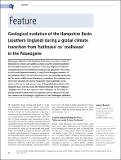Files in this item
Geological evolution of the Hampshire Basin (southern England) during a global climate transition from ‘hothouse’ to ‘coolhouse’ in the Palaeogene
Item metadata
| dc.contributor.author | Barnet, James Stewart Kinmond | |
| dc.date.accessioned | 2023-03-30T13:30:01Z | |
| dc.date.available | 2023-03-30T13:30:01Z | |
| dc.date.issued | 2023-03-29 | |
| dc.identifier | 283643310 | |
| dc.identifier | 05be326d-3309-4ced-af1c-cd733cc87192 | |
| dc.identifier | 85151546923 | |
| dc.identifier.citation | Barnet , J S K 2023 , ' Geological evolution of the Hampshire Basin (southern England) during a global climate transition from ‘hothouse’ to ‘coolhouse’ in the Palaeogene ' , Geology Today , vol. 39 , no. 2 , pp. 54-61 . https://doi.org/10.1111/gto.12423 | en |
| dc.identifier.issn | 0266-6979 | |
| dc.identifier.other | ORCID: /0000-0003-3885-5664/work/132214217 | |
| dc.identifier.uri | https://hdl.handle.net/10023/27300 | |
| dc.description.abstract | Palaeogene sediments of the Hampshire Basin were a sensitive recorder of fluctuations in climate and eustatic sea level as Earth's climate transitioned from the global early Eocene ‘hothouse’ to the early Oligocene ‘coolhouse’, accompanied by the first permanent continent-scale glaciation of Antarctica at the Eocene/Oligocene boundary. A study of the Palaeogene sediments of the Hampshire Basin is not only interesting from a palaeoclimate perspective, but the marine middle Eocene formations are renowned for containing some of the most abundant and diverse Palaeogene fossil assemblages in the world. In this article, I take you on a tour of the geological evolution of the Hampshire Basin from the end of the Paleocene through to the Pleistocene. I highlight some of the best exposures where sediments can be studied at outcrop and representative fossil assemblages can be collected, along with the economic and archaeological significance of these Palaeogene sediments. | |
| dc.format.extent | 8 | |
| dc.format.extent | 4799400 | |
| dc.language.iso | eng | |
| dc.relation.ispartof | Geology Today | en |
| dc.subject | QE Geology | en |
| dc.subject | 3rd-DAS | en |
| dc.subject | SDG 13 - Climate Action | en |
| dc.subject | SDG 14 - Life Below Water | en |
| dc.subject | MCC | en |
| dc.subject.lcc | QE | en |
| dc.title | Geological evolution of the Hampshire Basin (southern England) during a global climate transition from ‘hothouse’ to ‘coolhouse’ in the Palaeogene | en |
| dc.type | Journal article | en |
| dc.contributor.institution | University of St Andrews. School of Earth & Environmental Sciences | en |
| dc.identifier.doi | https://doi.org/10.1111/gto.12423 | |
| dc.description.status | Peer reviewed | en |
This item appears in the following Collection(s)
Items in the St Andrews Research Repository are protected by copyright, with all rights reserved, unless otherwise indicated.

